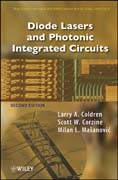
Diode lasers and photonic integrated circuits
Coldren, Larry A.
Corzine, Scott W.
Mashanovitch, Milan L.
Diode Lasers and Photonic Integrated Circuits, Second Edition provides a comprehensive treatment of optical communication technology, its principles and theory, treating students as well as experienced engineers to an in-depth exploration of this field. Diode lasers are still of significant importance in the areas of optical communication, storage, and sensing. Using the the same well received theoretical foundations of the first edition, the Second Edition now introduces timely updates in the technology and in focus of the book. After 15 years of development in the field, this book will offer brand new and updated material on GaN-based and quantum-dot lasers, photonic IC technology, detectors, modulators and SOAs, DVDs and storage, eye diagrams and BER concepts, and DFB lasers. Appendices will also be expanded to include quantum-dot issues andmore on the relation between spontaneous emission and gain. INDICE: Preface. Acknowledgements. List of Fundamental Constants. 1. Ingredients. 1.1 Introduction. 1.2 Energy Levels and Bands in Solids. 1.3 Spontaneous and Stimulated Transitions: the Creations of Light. 1.4 Transverse Confinement of Carriers and Photons in Diode Lasers: the Double Heterostructure. 1.5 Semiconductor Materials for Diode Lasers. 1.6 Epitaxial Growth Technology. 1.7 Lateral Confinement of Current, Carriers, and Photons for Practical Lasers. 2.A Phenomenological Approach to Diode Lasers. 2.1 Introduction. 2.2 Carrier Generation and Recombination Active Regions. 2.3 Spontaneous Photon Generation and LEDs. 2.4 Photon Generation and Loss in Laser Cavities. 2.5 Threshold or Steady-State Gain in Lasers. 2.6 Threshold Current and Power Out vs. Current. 2.7 Relaxation Resonance and Frequency Response. 2.8 Characterizing Real Diode Lasers. 3. Mirrors and Resonators for Diode Lasers. 3.1 Introduction. 3.2 Scattering Theory. 3.3 S and T Matrices for some Common Elements. 3.4 Three- and Four-Mirror Laser Cavities. 3.5 Gratings. 3.6 DBR Lasers. 3.7 DFB Lasers. 3.8 Mode Suppression Ratio in Single-Frequency Lasers. 4. Gain and Current Relations. 4.1 Introduction. 4.2 Radiative Transitions. 4.3 Optical Gain. 4.4 Spontaneous Emission. 4.5 Nonradiative Transition. 4.6 Active Materials and their Characteristics. 5. Dynamic Effects. 5.1 Introduction. 5.2 Review of Chapter 2. 5.3Differential Analysis of the Rate Equations. 5.4 Large-Signal Analysis. 5.5 Relative Intensity Noise and Linewidth. 5.6 Carrier Transport Effects. 5.7 Feedback Effects. 6. Perturbation and Coupled-Mode Theory. 6.1 Introduction. 6.2 Perturbation Theory. 6.3 Coupled-Mode Theory: Two-Mode Coupling. 6.4 Modal Excitation. 6.5 Conclusions. 7. Dielectric Waveguides. 7.1 Introduction. 7.2 PlaneWaves Incident on a Planar Dielectric Boundary. 7.3 Dielectric Waveguide Analysis Techniques. 7.4 Guided-Mode Power and Effective Width. 7.5 Radiation Losses for Nominally Guided Modes. 8. Photonic Integrated Circuits. 8.1 Introduction. 8.2 Tunable Lasers and Laser-Modulators with In-Line Grating Reflectors. 8.3 PICs using Directional Couplers for Output Coupling and Signal Combining. 8.4 PICs using Codirectionally Coupled Filters. 8.5 Numerical Techniques for Analyzing PICs. Appendices. 1. Review of Elementary Solid-State Physics. 2. Relationships between Fermi Energy and Carrier Density and Leakage. 3. Introduction to Optical Waveguiding in Simple Double-Heterostructures. 4. Density of Optical Modes, Blackbody Radiation, and Spontaneous Emission Factor. 5. Modal Gain, Modal Lose, and Confinement Factors. 6. Einsteins Approach to Gain and Spontaneous Emission. 7. Periodic Structures and the Transmission Matrix. 8. Electronic States in Semiconductors. 9. Fermis Golden Rule. 10. Transition Matrix Element. 11. Strained Bandgaps. 12. Threshold Energy for Auger Processes. 13. Langevin Noise. 14. Derivation Details for Perturbation Formulas. 15. The Electro-Optic Effect. 16. Solution of Finite Differ
- ISBN: 978-0-470-48412-8
- Editorial: John Wiley & Sons
- Encuadernacion: Rústica
- Páginas: 704
- Fecha Publicación: 20/01/2012
- Nº Volúmenes: 1
- Idioma: Inglés
